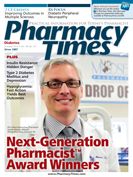Publication
Article
Pharmacy Times
Type 2 Diabetes Brown Bag
Adherence to therapy and proper blood glucose monitoring are 2 important counseling points for patients with diabetes.

Adherence to therapy and proper blood glucose monitoring are 2 important counseling points for patients with diabetes.
It has been estimated that nearly 1 in 10 individuals in the United States have diabetes. In the community pharmacy setting, we dispense drugs to treat diabetes on a daily basis. The pharmacy team can play a large role in proper diabetes education and care, however.
Lowering glucose levels and A1C are important goals for any patient with diabetes. It is known that an A1C within guidelines can help prevent microvascular complications such as nephropathy, retinopathy, and neuropathy. Reaching blood pressure and lipid goals are also important steps for patients with diabetes. The community pharmacy can help serve not only as a resource, but also as a hub for accessible clinical services and diabetes care.
Brown bag sessions for patients with diabetes can help you monitor compliance and check for the appropriateness of drug therapy, cost-saving opportunities, and therapy duplications or interactions.
JL is a 67-year-old woman and retired school administrator who does not have a very active lifestyle. JL is coming into your pharmacy today to pick up her monthly refills. You noticed a few months ago that she was having trouble with adherence and, after much work, you were finally able to get all 7 of her prescription medications refilled at the same time. JL is very happy about this, uses only your pharmacy, and hopes this will help her better manage her various conditions.
JL often needs to be asked questions during a counseling session, as she will not offer up information. You notice JL is scanning blood glucose meters in the aisle before you and this prompts you to ask her about her daily diabetes regimen. JL expresses that she is afraid of needles and asks you to not only recommend a meter but to also help her get comfortable using the meter. You suggest a brown bag session and explain to her that you would like to review her medications for accuracy in addition to teaching her about the new meter and strips. JL will stop back in tomorrow at a time when you have overlap pharmacist coverage. JL arrives the next day and her brown bag contains:
- One Touch Ultra meter and test strips
- OTC aspirin 325 mg once daily
- Metformin 1000 mg twice daily
- Pioglitazone 45 mg once daily
- Atorvastatin 40 mg once daily
- Enalapril 5 mg once daily
- Furosemide 40 mg once daily
- Levothyroxine 25 mcg once every morning
- Lorazepam 0.5 mg as needed for anxiety
- OTC multivitamin once daily
Without having lab values or a medical chart at your disposal, you review JL’s medications and make some initial suggestions. You ask JL if she would like to follow up with a medication therapy management (MTM) session. She is not interested at this time but promises that she will follow up with you on her blood sugar testing technique and call you back with her glucose numbers and last A1C. From your professional relationship with her health care providers, you know JL is very compliant with lab work and keeping her appointments.
After reviewing the blood glucose meter with JL and helping her get comfortable testing her blood sugar, you suggest the following:
- JL is taking OTC non—enteric-coated (EC) aspirin 325 mg. She bought this because it was a bulk bottle on sale. You express that her cardiologist may want her to be on EC 81 mg aspirin for cardiovascular prophylaxis. You offer to followup for her and also mention that an EC formulation will be safer long term on her stomach.
- Depending on JL’s blood sugar numbers pre- and post-meals and her A1C, you offer to followup with her provider on whether the metformin and pioglitazone are her best options. She agrees to keep you updated so you can help her make it a less confusing process.
- You perform 3/3 blood pressure checks and notice JL’s blood pressure is 143/96 mm Hg. You will follow up with the prescriber on JL’s enalapril and furosemide doses and check to see if the provider still deems this appropriate therapy.
- JL admits that she has gained some weight in the past 6 months and has not had her thyroid levels checked in more than a year. You recommend she have her thyroid checked to determine the appropriate levothyroxine dose, as her weight gain may be contributing to this being off balance.
What other suggestions for JL do you have? How can you encourage her to participate in an MTM session?
Dr. Drury works as a clinical pharmacy specialist in Chicago, Illinois, and Milwaukee, Wisconsin. She earned her doctor of pharmacy from Midwestern University College of Pharmacy in 2007. In addition to her current work, she is a blogger for PharmacyTimes.com and a speaker for Abbott Pharmaceuticals.







